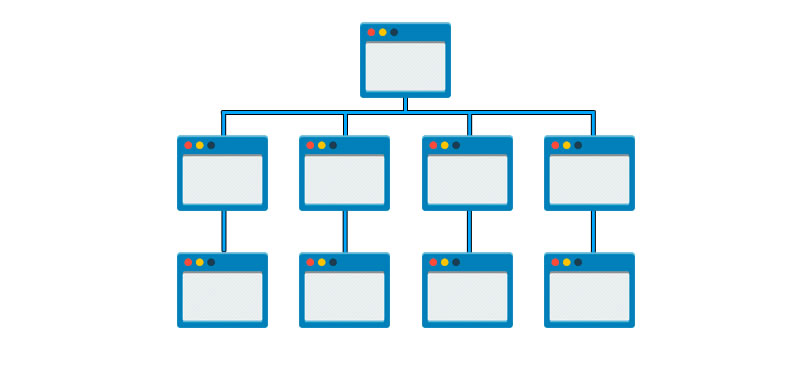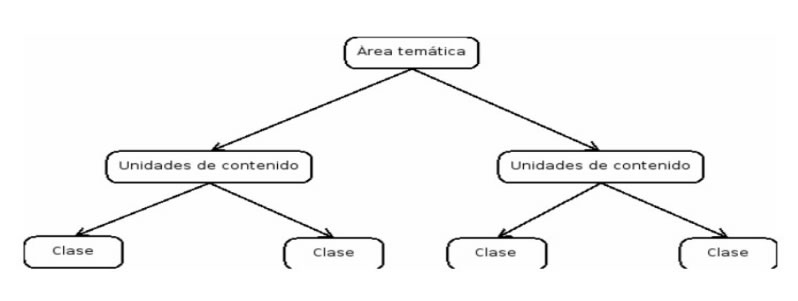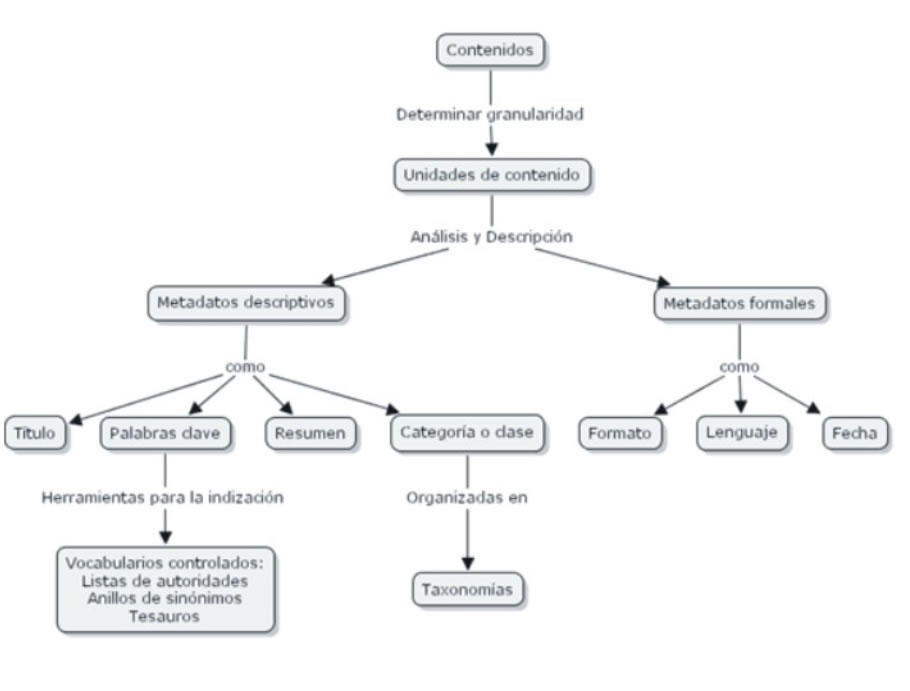Taxonomy Organization of information for Web Content
The organization of content on a Web page facilitates the use of the product by the end user, improving the efficiency of information retrieval.

Human society has always generated knowledge about its environment and the physical and social reality that surrounds it. This arises from man's own need to try to explain or understand the environment he inhabits. But, in the current forms of social organization, it has acquired a dimension and a place in society, which goes beyond its historical function. Today, the role of knowledge in organizations has changed dramatically as a result of the emergence of new paradigms, associated with the so-called information society and a new economy, based on knowledge.
The development of so-called new information and communication technologies (NICTs) changes society and if the medium is transformed, then access to information also changes, which is much faster, wider and more precise today. There is a greater demand for information and a more direct participation in the search for information by users.
Under this dynamic, NICTs can provide part of the conditions related to the implementation of knowledge management, by supporting and enhancing the capabilities of each member of an organization.
In recent years, various systems of knowledge organization (SOC) have been used successfully to organize information on the World Wide Web: from traditional classification systems and thesauri, to the most recent taxonomies, ontologies and semantic networks.
A site that contains well-structured and classified information can be easily understood by other websites and by search engines, as well as better meet its objectives of disseminating information as widely as possible, in addition to allowing the user to find what they are looking for.
Describing and categorizing the contents of a website would not make sense if it did not facilitate the interaction between the user and the information space, the way and how the user can navigate and explore the website in search of the information needed. In this sense, taxonomies have a fundamental place, because they allow creating a hierarchy and organization of the contents presented in a site.
In the early 90s of the twentieth century, the concept of taxonomy is incorporated into various fields of knowledge, such as psychology, social sciences and information technology, to designate almost all systems of access to information that attempt to establish coincidences between the user and system terminology. The first specialists who developed content organization systems for the Web were part of the knowledge management consulting area, and came from environments close to computer science and engineering-content management and information architecture; they did not know the tradition of the documentary language of Library Science and Documentation, and then, they assigned the term taxonomy to the systems they developed. This term is still in use today to designate systems for organizing content in the context of the Internet, although the theory and practice of documentary languages is applied intensively in this context.
Therefore, in this contribution, it is intended to assess the use of taxonomies for the organization of content on websites in general.
Taxonomies and the organization of content on Web sites
Due to the popularity that the Web has acquired in recent years, and the constant progress in this field, those who organize the knowledge have developed a series of skills, experiences and methods to perform this type of task. These methods have substantially supported the improvement of the organization of the contents exposed in a Web, on the basis of some organizational criteria, among which are the taxonomies; they have made it possible for the development time of Web sites to be shorter, and consequently, to build a Web with greater speed.
A good organization of the contents exposed in a Web will facilitate the use of the product to the final user, improve the efficiency of the recovery of information and therefore achieve an efficient management of information and knowledge; the greater the structuring and organization of the information, the easier it will be for the user to find what they really want, in addition to the evidence that sites with a high level of organization of their contents are much more visited in the Word Wide Web.
Many times users know exactly what they are looking for, they know the labels and terms that they should use to find what they are looking for, they just want to find it and leave. Others, on the other hand, do not know what they are investigating. They come to the site with a vague idea of the information they need; They can not even know the labels to describe what they want or even if they exist or not. This has its advantages because while they occasionally explore the site to find what they need, they can learn about products and leave the site with knowledge (or products) that they did not know before, nor did they know they needed them, and this can be achieved because the system is well designed, there is a structure and an organization of the contents.
The development of the NICTs supports, in a certain sense, this activity, but it is only the specialists who are capable and must know how to select and organize the contents. The content is a matter exclusive of the individuals, the technologies only facilitate their management.
Creating an easy-to-use Web page is not an easy task. A positive interactive experience is derived in many cases from the correct organization of the contents of a Web, and from taxonomies that allow it and facilitate it.
If we want to design a page that the end user can use, generate a positive interactive experience and, in turn, turn out to be a profitable project, we must not lose sight of the fundamental role played by taxonomies in this regard. As predetermined structures that are used to divide a thematic area -in this case, the thematic area refers to the content of the site-, and these areas in other smaller ones and so on, they make it possible to organize and structure the contents in classes, starting of properties of concepts, by their similarity. It is then required a conceptual analysis that differentiates these concepts (classes) and in turn, groups them according to their characteristics.
Many authors have addressed the issue of taxonomies, for example, Abed Gregio states that:
“A taxonomy is a scientific process (or a particular system) of categorizing entities, that is, of organizing them into groups. A taxonomic system of being clear and consistent, flexible, exhaustive and practical”.
The same author further states that the basis for the development of a good taxonomy are the taxonomic characteristics, which are the properties or characteristics of the objects that will be categorized; These taxonomic characteristics are commonly referred to as attributes and must meet or meet the following requirements:
- Objectivity: when the characteristic is identified on the basis of an objective knowledge exclusively. The object (attribute) must be clearly observed.
- Determination: when there is a clear process that can be followed to identify (extract) the characteristic.
- Reproducibility: when several people independently describe (extract) the characteristics of the same object and coincide in the observed value.
- Mutually exclusive: when the inclusion of a group in a category excludes it from categorization in any other category.
- Comprehensive: when groups include all possibilities.
- Acceptable: logically and intuitively: so that the community accepts the categories.
- Useful: when it can be used to obtain knowledge in the field of investigation
From this, it follows that a taxonomy applied to a Web site is a hierarchical organization, which is used to structure content, it divides these into classes and groups them according to their characteristics. Therefore, they favor navigability and also facilitate access to the intellectual capital of a certain organization.

Of course, this definition is not the only one. In fact, there are many offered by different authors, especially based on the processes that must be followed for the construction of any taxonomy.
In fact, the ultimate goal, when developing a taxonomy, is to improve the organization of content through the representation of information.
What may seem like a "quick and easy" task, defining the structure of navigation and the organization of the contents of a website, is also one of the most critical factors of success. The structure of the site, also designated as the architecture or the taxonomy of the information, is the foundation of the Web site. Creating an effective taxonomy is both an art and a science. If incorrect terms are used, users will not be able to navigate intuitively. Creating a site that is too deep will result in the user having a harder time finding the content they are looking for.
Taxonomies, the information architecture and the information professional
In the discipline of Information Architecture (AI), the term "taxonomies" is frequently used, something very logical if one considers that the IA is in charge of structuring and organizing the contents (information) in Web products.
If we circumscribe exclusively to the AI in the field of the Web, one of the definitions offered by Rosenfeld and Morville can be easy to understand:
“… It is the art and science of structuring and classifying the contents of websites and intranets in order to help users find and manage information”
In practice, the "information architect" creates a large part of the foundations for organizing the content of a site, regardless of where the content of the site resides, be it in a multimedia, in fields of a database or in sites complexes and portals; he creates the structure or map of information that enables others to find their own paths to knowledge. It does not deal with the formal aspects of the design of the interfaces, from the point of view of the AI, the interface tends to be transparent, what matters is the content and the way in which the user accesses it, so that it can Manage it, navigate them easily and meet your information needs. The "information architect" helps to prevent the lack of organization from turning the user's experience into a nightmare.
In the outline of the content organization that Montero presents, it clearly shows how in the field of the AI the taxonomies are used for the organization of the contents to be developed in a Web product.

Its author illustrates how the information architect organizes and structures the content, analyzes its nature, determines its level of granularity, until physically it can not be further decomposed, how it introduces the descriptive metadata and so on until it reaches the categories or classes organized in taxonomies.
In the methodological steps that are applied to create the information architectures, the information professional is very present in his role as information architect for the organization of the contents of a Web product.
In step three and four specifically of the guide proposed by Montes de Oca can be seen:
In step three, "Determination of contents and functional requirements", the author affirms that upon reaching this point, there is enough information to be able to determine the contents. "And that in turn, with the analysis of the competition, (performed in previous steps), you can identify a group of contents that may be appropriate to the site that will be created, be it for similar products, organizations with similar missions or to have a universe of potential users with similar informative needs and characteristics ... "The author must analyze, and the author expresses very well, the informative needs identified in the study of the users to determine which contents are the most appropriate for meet the existing needs and sources of information where these contents will be extracted, because for each thematic group, there are specific elements of content and specific functional requirements.
In step four: "Defining the structure of the site", the author proposes that the content selected in the previous step should be labeled, these should be understandable to users and, at the same time, representative of the content they contain.
At a deeper level, when entering to analyze the labels that will represent the content, there are the taxonomies or taxa that allow to achieve a better structuring and a higher level of organization of the contents that we wish to represent.
Once the labels that will designate the content have been determined, the creation of the information organization structures and structures is what Josef Hassan calls in his proposed methodological guide, conceptual design. In this sense, he states: "the best way to ensure the adaptability of a website is through the separation of content, presentation, logical structure and interaction"
As can be seen, the role of an information architect is to organize large amounts of content, with the aim that the user can manage them, navigate them easily and meet their information needs. In other words, organize the disorder, make recoverable, locatable or accessible information and in this sense, taxonomies have a fundamental place.
Main elements to build a taxonomy
Construction of taxonomy
According to Centelles, the construction of taxonomies involves the realization of four processes:
- Delimitation of reality - entity, area of knowledge, industrial sector, etc. - that will represent the taxonomy
- Extraction of the set of terms or categories that represent said reality
To carry out this process it is necessary to establish, which are the priority sources and the appropriate extraction mechanisms for each one of them.
There are three types: personal sources, integrated by Web users and specialists in the Web domain; the documentary sources, integrated by documents representative of the types of contents identified in the strategic planning phase and the taxonomies and instruments available for the representation of knowledge - ranging from the nomenclatures of the units and existing resources in an entity to the tables of classification of administrative documentation.
The result of this process is a register of representative terms or categories.
- Terminological control of the terms or categories
The different terms that designate the same concept are identified; If there are two or more, it is necessary to determine which is considered preferred and which are considered non-preferential. Second, it is necessary to give a correct and consistent form to all the terms of the taxonomy, regardless of whether or not they are preferred.
The result of this process is the establishment of an equivalence relation between the terms of the taxonomy.
- 4. Establishment of the scheme and organizational structure of the terms or categories
The organization scheme includes the criteria or criteria used to divide and group the categories .... the criteria are unlimited and their suitability depends on the object that you want to represent through the taxonomy.
Some examples of the criteria most used are: subjects, subjects and disciplines, people, entities, recipients, processes, tasks and functions, types of documents, and so on.
The structural model defines the type of relationship that is established between groupings of categories derived from the organization scheme.
Traditionally, two techniques have been distinguished for the development of the structure of the taxonomy: the top-down technique ("up to down") and the "down-to-up" technique:
- The application of the technique from top to bottom involves the initial identification of a limited number of higher categories, and the grouping of the rest of the categories into successive levels of subordination until reaching the levels of more specific categories
- The application of the technique from the bottom up is based on the initial identification of the most specific categories, which are grouped into successive levels of superordination until reaching the level of higher categories
To all this, it could be added that it is fundamental, when building a taxonomy, to know all the terminology that will be used, both in the case of a taxonomy for a Web site and for a specific organization. Nobody better than a well qualified person, and with a solid knowledge of the domain for which he works to know how to build a taxonomy.
Final considerations
Knowing how to organize electronic contents, analyze them, process them and represent them synthetically is becoming more and more necessary in the Web environment. To the extent that they are more organized and better structured, users will recover and use the available content more successfully, and this will consequently result in effective knowledge management.
Taxonomies, when you want to develop a content management system, have a privileged place, and therefore, it is essential to know what they are used for, how they are used, how they work, how to build them, who is responsible for their creation and maintenance and, above all, how to validate them.
The architecture of information is one of the disciplines that is currently responsible for building taxonomies for the organization and representation of the contents on the Web and it is a kind of fundamental tool for this. The information architect responsible for complying with this task must always consider that the greater the degree of description of the content units, the greater the options for navigation for the user.
CITE ARTICLE
For homework, research, thesis, books, magazines, blogs or academic articles
APA Format Reference:
Delgado, Hugo. (2019).
Taxonomy Organization of information for Web Content.
Retrieved Nov 11, 2025, from
https://disenowebakus.net/en/taxonomy-information-web-content






